People in the know don’t call butterflies “butterflies” – they call them “leps,” which is short for Lepidoptera, the order of insects that includes not only butterflies, but moths and skippers. You can tell these apart by their antennae: true butterflies have straight skinny antennae with little bulbs at the tips; moths have antennae shaped like tiny feathers; and skippers have long straight antennae that curl backwards at the end, like question marks or fishhooks.
There are about 20,000 species of butterflies worldwide, 800 of which live in North America – and spotting as many of these as you can find is a terrific and addictive challenge for the spring and summer.
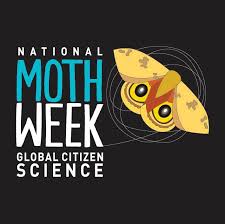 |
Visit the National Moth Week website for moth facts, moth activities, methods for attracting moths, instructions for making a moth feeder, a citizen science data-collecting project (everybody welcome to participate), and more. |
 |
Or celebrate National Learn About Butterflies Day on March 14. |
Table of Contents
MOTH AND BUTTERFLY STORIES
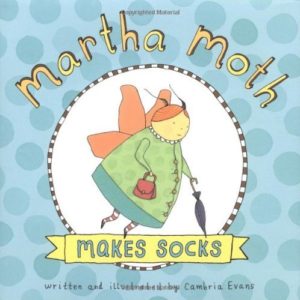
|
In Cambria Evans’s Martha Moth Makes Socks (Houghton Mifflin, 2006), the socks aren’t just footwear – they’re food, destined for a moth birthday dinner. Martha goes shopping and buys a polka-dot scarf, a shrunken sweater, and a pair of itchy socks, all intended for a fabulous feast. Unfortunately she tastes so much of her woolly dishes that, by the time the guests are due arrive, there’s practically nothing left to eat. Luckily her friends show up with just the right (edible) gift. For ages 4-7. |
| Actually it’s not moths that eat wool. It’s the larvae – caterpillars – of certain moths that chow down on sweaters, scarves, and socks. Find out just why. | |
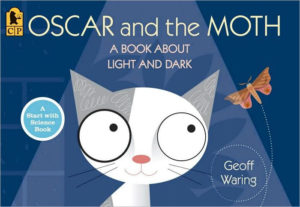
|
Geoff Waring’s Oscar and the Moth (Candlewick, 2008) is an early science book in which Oscar, a goggle-eyed kitten, learns about light and dark from the very helpful and talkative Moth. Covered are common sources of light, what causes day and night, and how shadows are made. For ages 4-8. |
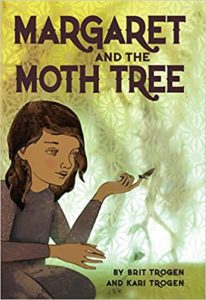
|
In Kari and Brit Trogen’s Margaret and the Moth Tree (Kids Can Press, 2012), Margaret, an orphan, is trapped in a dreadful orphanage presided over by the evil Miss Switch. Margaret, condemned by Miss Switch to absolute silence, discovers that she can hear things that others can’t – notably the tiny voices of the moths who live in a nearby thorn tree. The moths eat Nimblers – the filmy stuff of dreams – and with their help, Margaret comes up with a plan to defeat Miss Switch and free the orphans from misery. For ages 8-12. |
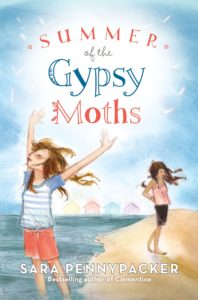
|
In Sara Pennypacker’s Summer of the Gypsy Moths (Balzer + Bray, 2012), 11-year-old Stella’s unstable mother is perpetually on the move – designing costumes in California, mining turquoise in Mexico – so Stella, along with Angel, an orphan in need of a foster home, has been sent to live with her great-aunt Louise on Cape Cod. When Aunt Louise suddenly dies, the two girls – fearful of what will happen to them – bury her secretly in the garden and embark on a series of elaborate deceptions to explain her absence. In the process, as they struggle to survive, they forge an unexpected friendship. The girls are polar opposites: Stella, a control freak, is painfully neat and addicted to “Hints from Heloise;” Angel is careless, messy, and rebellious. (They also battle gypsy moths.) Well-written, though the premise and the extremely tidy ending are somewhat unbelievable. For ages 10 and up. |

|
In Gene Stratton-Porter’s now-classic A Girl of the Limberlost (Empire Books, 2011), originally published in 1909, Elnora Comstock, growing up on the banks of Indiana’s Limberlost Swamp, struggles to pay for her education – in the teeth of her obstructive mother – by selling moths from the nearby swamp to collectors. As well as print, the book is available online. For ages 12 and up. |
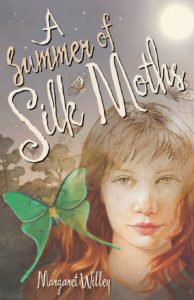
|
In Margaret Willey’s A Summer of Silk Moths (Flux, 2009), seventeen-year-old Pete is passionately devoted to helping his mentor Abe maintain Riverside, a nature preserve dedicated to the memory of Abe’s brother Paul – and to sketching Paul’s beautifully preserved moth collection. Into this idyll comes the angry and disruptive runaway Nora, who claims to be Paul’s daughter. Collecting moths – and reading Paul’s moth journal – eventually bring Pete and Nora together as they solve mysteries of their pasts. For ages 13 and up. |

|
Virginia Woolf’s 1942 essay “The Death of the Moth” is a recommended read for high-school students. |
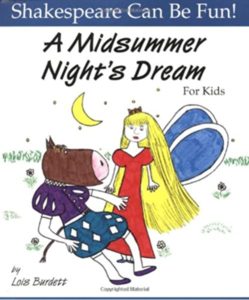
|
And don’t forget Peaseblossom, Cobweb, Moth, and Mustardseed, Titania’s fairies in Shakespeare’s Midsummer Night’s Dream. The play is available in many editions, among them Lois Burdett’s adaptation, A Midsummer Night’s Dream for Kids (Firefly Books, 1997), illustrated with terrific children’s drawings, in which the plot is summarized in catchy rhyming couplets. For ages 5-8. |
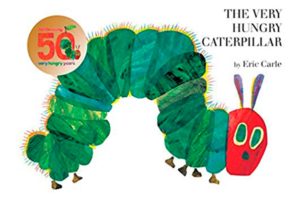
|
In Eric Carle’s The Very Hungry Caterpillar (Philomel, 2010), illustrated with gorgeous paper collages, the caterpillar eats his way through a week (starting with an apple on Monday) – then forms a chrysalis and hatches out as a spectacularly beautiful butterfly. For ages 2-6.
See a lovely animated film version of The Very Hungry Caterpillar. |
 |
Make an egg-carton caterpillar! You’ll need green paint, green pipe cleaners, and wiggle eyes. |
| Butterfly and caterpillar crafts! Make craft-stick caterpillars and a great fold-out caterpillar-to-butterfly project. | |
| Pet caterpillars? Here’s how to make your own caterpillar habitat. | |
 |
Grow these great grass caterpillars! |
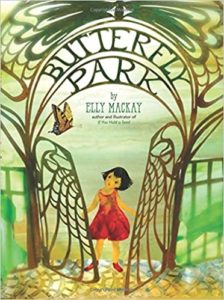
|
In Elly MacKay’s Butterfly Park (Running Press, 2015), a little girl moves to a new town and discovers Butterfly Park – where there are no butterflies. With the help of other neighborhood children, she finds a way to bring the butterflies back. The 3-D lightbox diorama illustrations are great. For ages 4-7. |
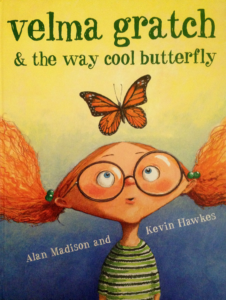 |
Sometimes a butterfly makes you special. In Alan Madison’s Velma Gratch and the Way Cool Butterfly (Dragonfly Books, 2012), first-grader Velma Gratch is outshone by two older and practically perfect sisters – until, on a trip to the Butterfly Conservatory, she’s adopted by a monarch butterfly. For ages 4-8. |
 |
Rudyard Kipling’s “The Butterfly That Stamped” from the Just So Stories (available in many editions) is a wonderful read for all ages about the wise King Suleiman-bin-Daoud, Queen Balkis the Most Beautiful, nine hundred and ninety-nine quarrelsome wives, and a very boastful butterfly. |
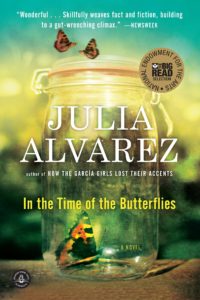
|
By Julia Alvarez, In the Time of the Butterflies (Algonquin, 2010), a historical fiction novel, is the story of the four beautiful Mirabal sisters – known as “the butterflies” – who opposed the rule of Trujillo in the Dominican Republic. Three of the sisters have been murdered by the regime, but one – DeDe – survives. A powerful work of literature for teens and adults. |
